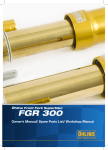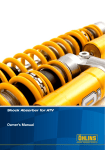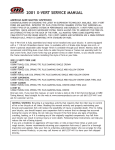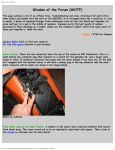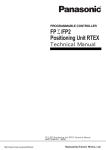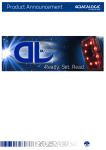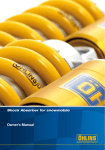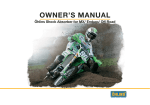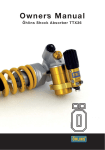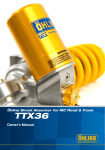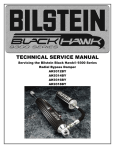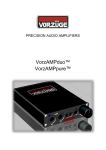Download Owner`s Manual/ Workshop Manual
Transcript
Shock Absorber for High Level Racing TTR Owner’s Manual/ Workshop Manual Öhlins Racing AB - The Story world titles are definitive proof that Öhlins shock absorbers offer outstanding performance and reliability. Every product has gone through rigorous testing and engineers have spent thousands of hours, doing their very best to use every possible experience from our 30 years within the racing sport. By installing this shock absorber on your vehicle you have made a clear statement… you are a serious driver with a focus on getting the maximal handling ability and outstanding feedback from your vehicle. Along comes the fact that your shock absorber will be a long lasting friend, delivering the very best of comfort and performance every time you go for a drive. Go explore! It was the 1970’s, a young man named Kenth Öhlin spent most of his spare time pursuing his favourite sport: motocross. A careful observer, Kenth’s attention was continually drawn to one specific detail - motocross bikes had more engine power than their suspension could handle. It was not long before Kenth realised that better performance could be achieved by improved wheel suspension. Öhlins Racing was established in 1976, and just two years later the company won its first World Championship title. Despite being in the business for 30 years, the search for perfection and new functions is still the main focus of the company. Congratulations! You are now the owner of an Öhlins Shock Absorber. More than three hundred World Championships and other major In This Manual Safety Precautions Service & Maintenance Design and Functioning External Adjusters Zeroing Valve Overview Revalve Workshop Section Page 2 3 3 4 5 8 9 12 1 Safety Precautions Note! Safety Symbols The shock absorber is an important part of the vehicle and will affect the stability. In this manual, mounting instructions and other technical documents, important information concerning safety is distinguished by the following symbols: Note! Read and make sure that you understand the information in this manual before you use this product. If you have any questions regarding installation or maintenance please contact an Öhlins dealer. The Safety Alert Symbol means: Warning! Your safety is involved. Warning! Warning! The Warning Symbol means: Failure to follow warning instructions can result in severe or fatal injury to anyone working with, inspecting or using the shock absorber, or to bystanders. Öhlins Racing AB can not be held responsible for any damage to the shock absorber, vehicle, other property or injury to persons, if the instructions for maintenance are not followed exactly. Warning! Caution! This product contains pressurized nitrogen gas (N2). Do not open, service or modify this product without proper education (authorized Öhlins dealer/distributor) and proper tools. The Caution Symbol means: Special precautions must be taken to avoid damage to the shock absorber. Note! Warning! The Note Symbol indicates information that is important regarding procedures. After installing this product, take a test drive at low speed to make sure that your vehicle has maintained its stability. Warning! Note! If the suspension makes an abnormal noise, or the function is irregular, or if you notice any leakage from the product, stop the vehicle immediately and return the product to an Öhlins Service Centre. When working on this product, always consult your Vehicle Service Manual. Note! This Manual shall be considered a part of the product and shall therefore accompany the product throughout its life cycle. Warning! The product warranty shall only apply if this product has been operated and maintained in accordance with recommendations in this manual. If you have any questions regarding usage, service, inspection and maintenance please contact Öhlins. © Öhlins Racing AB. All rights reserved. Any reprinting or unauthorized use without the written permission of Öhlins Racing AB is prohibited. Printed in Sweden. 2 service and maintenance After every use • Measure the position of the separating piston. See Chapter 9 Check Oil Level in the Workshop Section. • Look for oil leakage. By keeping the damper clean and dry, any leakage will be easy to detect. If oil is leaking from the X-ring seal repeatedly, replace X-ring and inspect the piston rod for imperfections on the surface. • Inspect the dampers for external wear or damage. • Check the spherical bearings regularly for excessive play. On installations where the spring is not of coil over type, a gap is more critical as the bearings will see loads in both directions. Recommended Service Intervals • After 30hours or 6000Km • After 15hours or 3000Km if working temperature exceeds 110°C If the shock absorber reaches a temperature of 140°C or more it needs immediate service. Recommended service, change/ replace; • oil • o-rings, x-rings • piston band • bushings Caution! If you have any questions regarding service and maintenance, please contact Öhlins. design and functioning Öhlins now releases the TTR damper – a 4-way fully independent adjustable damper based on well proven technology that has been behind winning success for many years in high-end factory racing in IndyCar, Le Mans and DTM. This high end racing damper is now available for teams seeking optimal performance and ontrack success. Features include a precise valving system, both high and low speed can be zeroed externally to ensure an accurate matching between dampers while at the same time maintaining reference clicks. The TTR damper combines top performance with user friendly handling, for instance change valving in close to one minute. The damper also comes with valving simulation software, drastically reducing time from idea to ready damper and helps making accurate adjustments at the track. Features • 4-way fully independent adjustable damper • Solid piston • Well proven valve technology • Through-rod design to minimize hysteresis • Large adjustment range • Top performance combined with easy handling • Change valving in close to 1 minute • Comes with valving simulation software • Precise valving system, both low- and highspeed can be zeroed externally. 3 external adjusters Low Speed Compression Damping Adjuster (LSC) Adjuster type: Identification: Number of positions: Click position 0: Bleed adjuster Gold coloured knob Approx. 55 (10 clicks/turn) Fully counter clockwise at minimum force (orifice open) Low Speed Rebound Damping Adjuster (LSR) Adjuster type: Identification: Number of positions: Click position 0: Bleed adjuster Silver coloured knob Approx. 55 (10 clicks/turn) Fully counter clockwise at minimum force (orifice open) High Speed Compression Adjuster (HSC) Adjuster type: Poppet valve Identification: Screw with internal 3mm hex (inside the gold casing) Number of positions: approx. 40 (8 clicks/turn) Click position 0: Fully counter clockwise at minimum force (spring min preloaded) High Speed Rebound Adjuster (HSR) Adjuster type: Poppet valve Identification: Screw with internal 3mm hex (inside the silver casing) Number of positions: approx. 40 (8 clicks/turn) Click position 0: Fully counter clockwise at minimum force (spring min preloaded) 4 zeroing Zeroing result See the examples below for results after calibrating Low Speed and High Speed Valve. To calibrate according to the example below see Low Speed Zeroing and High Speed Zeroing on the following two pages. Note! When calibrating, we recommend to calibrate Low Speed and High Speed in the same order as performed below. The Low Speed Bleed affects the High Speed Valve. Low Speed Zeroing 1 2 Actual curve Reference curve Calibrate Low Speed Bleed High Speed Zeroing 3 4 Calibrate High Speed Valve Recommended Tools when Zeroing Tool Part no Adjustment tool 01899-01 Screwdriver 1mm hex screwdriver 1.3mm hex screwdriver 3mm hex screwdriver 5 zeroing Low Speed Zeroing Choose one of your shock absorbers that is closest to the Valving Reference Program (VRP) as a reference. 2 1 Check in the dyno the number of clicks needed to close or open the adjuster to match your reference. 2 Turn the adjuster to fully open by turning counter clockwise until stop. 3 3 Note that there are two lock screws, one on each side of the adjuster. Unlock these; 3.1 Turn the adjuster half a turn clockwise so that you can unlock (½ turn) the screw that was facing in. Use a 1.3mm hex screwdriver. 3.2 Turn the adjuster counter clockwise until stop. Loosen the screw facing out. 3.1 ½ turn ½ turn 3.2 ½ turn 4 Use a screwdriver and turn the slotted centre screw. Turn the number of clicks that was defined in step 1. Note that one groove, or the distance between two peaks, equals one click. Turn clockwise to obtain increased force. Turn counter clockwise to obtain less force. 4 =1 click =1 =1 etc 5 Push the knob towards the cylinder head and at the same time lock the screw facing out. 6 Turn the adjuster half a turn clockwise. Push the knob and lock the screw that was facing in. 5 7 Turn the adjuster to fully open by turning counter clockwise until stop. 8 Set the adjuster to the desired number of clicks. Run the shock absorber once again in the dyno to confirm your set-up. 6 zeroing High Speed Zeroing Note! 2 When zeroing, first zero low speed and then high speed. 1 Loosen the 1mm hex screws. Note that there are two on each side of the two Adjustment housings. + 3A 1 2 Use a 3mm hex screwdriver to fixate the Adjustment screw. 3 Use tool 01899-01 (3A) to zero. Turn counter clockwise to obtain less damping force. Turn clockwise to obtain increased damping force. - 3 2 Fixate Adjustment screw Note! Normally you will only need to turn until you hear a noticeable click, or less. 4 Lock the 1mm hex screws by only slightly tightening each screw at a time in a cross pattern not to make the Inserts skewed into the Adjustment housing. 7 valve overview G47 G57 Valve and Valve Seat G67 D50 D70 06183-47 06183-57 06183-67 06185-50 06185-70 06198-47 06198-57 06198-67 06197-50 06197-70 Shuttle Guide Spring x.x Shuttle Guide Spring Part No. ØD (mm) Part No. T (mm) (N/mm) 06195-10 1.0 06196-20 1.9 20 06195-15 1.5 06196-30 2.1 30 06195-20 2.0 06196-40 2.25 40 06196-50 2.34 50 8 revalve Recommended Tools when Revalving Tool Part no Clamp tool 01878-01 Adjuster house tool 01898-01 Öhlins High Performance fluid 01304-XX 1 Torque wrench Small pliers Note! Every time you revalve the oil level and the amount of air in the shock absorber will be slightly increased. Therefore we recommend that after approximately five [5] revalvings Check the Oil Level and Vacuum Fill, see Chapter 9-10 in the Workshop Section. 2 1 Put the shock absorber in a vice. Use clamp tool 01878-01. 2 Depressurize the shock absorber. See chapter 1 Pressure. 3 3 Use tool 01898-01 and a torque wrench. Press the tool down in a straight line so that the pins on the tool are aligned with the holes in the Adjustment housing. Remove the Adjustment housing. To Replace Valve Spring - Go to 4.1 To Replace Valve/ Valve seat and Shuttle Guide - Go to 4.2 9 revalve 4.1 Replace Valve Spring 4.1.1 4.1.1 Use small pliers and remove the Valve spring. 4.1.2 Replace the Spring. 4.1.3 Pour oil up to the edge of the valve cavity. Note! Only use Öhlins High Performance fluid. 4.1.4 Mount the Adjustment housing. 01898‑01 and a torque wrench. Tightening torque 10Nm Use tool 4.1.3 4.1.4 10 revalve 4.2 Replace Valve and Valve seat 4.2.1 Use small pliers and remove the Valve spring. 4.2.1 4.2.2 Use small pliers and remove the Valve. Pour out some of the oil that may come with the Valve. 4.2.2 4.2.3 Remove the Shuttle guide and Valve seat. 4.2.3 4.2.4 Remove the Check valve shim, Wave washer, Support shim and the Circlip from the Valve seat. 4.2.5 Put the Check valve shim, Wave washer, Support shim and the Circlip on the new Valve seat. 4.2.4 Note! Shuttle guide Note the Wave washer position. Circlip 4.2.6 Put the new Valve seat on the Shuttle guide. Note the position of the Shuttle guide legs. Make sure that the Valve seat snaps on to the Shuttle guide. Valve seat 4.2.7 Put the Shuttle guide, Valve and Spring back into the Cylinder head. 4.2.8 Pour oil up to the edge of the cavity (see figure 4.1.3). Support shim Wave washer Check valve shim Valve seat 4.2.6 Note! Only use Öhlins High Performance fluid. 4.2.7 4.2.9 Mount the Adjustment housing. Use tool 01898‑01 and a torque wrench (see figure 4.1.4). Tightening torque 10Nm 11 workshop section Contents Chapter Recommended Tools Page Tools 12 1 Pressure 1.1 Prepare Gas Filling Device 13 1.2 Depressurize 14 1.3 Pressurize 15 2 Reclock Top Eye 16 3 Add/Replace Spacers 3.1 Disassemble 17 3.2 Assemble 19 4 Replace Piston Rod 4.1 Disassemble 20 4.2 Assemble 21 5 Replace Cylinder Tube 5.1 Disassemble 22 5.2 Assemble 23 6 Replace Top Eye 6.1 Disassemble 25 6.2 Assemble 26 7 Replace Seals/Bushings/Bearings and/or Membrane 7.1 Disassemble 27 7.2 Assemble 28 8 Fill Oil 29 9 Check Oil Level 31 10 Adjust Oil Level 10.1 Prepare Oil Syringe 32 10.2 Add Oil 33 10.3 Remove Oil 34 Tool Part No Assembly lubricant - Red grease 00146-01 Soft jaws 00727-02 Soft jaws 00727-03 Sleeve 00737-05 Spanner 00738-01 Vice 00773-01 Öhlins High Performance Fluid 01304-XX Peg spanner 01761-01 Peg spanner 01761-03 Öhlins 21mm wrench 01772-03 Gas Needle Housing 01779-02 Gas Filling Device 01781-01 M5 Adapter 01820-01 Öhlins Vacuum Filling Machine 01840-01 Öhlins Vac. Filling Machine Manual 07221-01 Mounting Sleeve 01861-XX Separating piston positioning tool 01876-XX Separating piston positioning spacer 01877-5X Clamp tool 01878-01 Syringe kit 01881-01 Adjuster House Tool 01898-01 Spring PL Tool 03199-01 Positioning pin 24602-01 Adjustable wrench Allen key 3mm Allen key 6mm Circlip pliers Heat gun Loctite Nitrogen gas (N2) Torx T20 and T25 Screwdriver Torque wrench Vice with soft jaws Wrench 10, 11 and 14mm 12 1 pressure 1.1 Prepare Gas Filling Device Note! If you have a TTX46MT shock absorber combined with the TTR shock absorber the gas filling device must to be modified before use. Replace needle housing (part no. 01779-01) included in the standard gas filling device (part no. 01781‑01) with needle housing (part no. 01779‑02). Needle housing 01779‑02 can be used on most Öhlins products.If you are working on a TTX46MT you do not need to modify the gas filling device. 1 11 mm 14 mm Quick coupling 01778-01 2 1.1.1 Remove the old Needle housing from the Quick coupling. Use an 11 mm and 14 mm wrench. Replace 01779-01 1.1.2 Remove the current Needle from the Housing by gently pushing it out. Note! 11 mm 3 Push the needle against a surface that will not damage the needle tip (some wood or plastic is recommended). 10 mm 1.1.3 Put the Needle into the new Needle housing and screw it back on the Quick coupling. Use a 10 mm and 11 mm wrench. 01779-02 Caution! Use a low tightening torque, approximately 5 Nm. 4 1.1.4 Check the length of the Needle. The visible length should be 14‑20 mm (measured to the tip of the needle). Caution! If the Needle is too short, it may not reach all the way through the Rubber membrane. If it is too long it may damage the Separating piston. 5 1.1.5 Make sure that the Needle is not damaged. Replace if you find burrs around the tip. Carefully grab the Needle between two fingers and gently move your fingers along the needle to look for damage. Warning! Be careful when checking the needle. 13 Quick coupling 01778-01 1 pressure 1.2 Depressurize 1.2.1 Remove the Screw and Washer covering the Membrane at the Reservoir end cap. Use a Torx T20 screwdriver. 1 Warning! Be careful when working with the Needle. 1.2.2 Apply some assembly lubricant on the Needle tip. Insert the tip into the Rubber membrane in the Reservoir end cap. Thread the Needle housing into the Reservoir end cap. 2 1.2.3 Attach the Quick-connect hose with the Gauge to the shock absorber. 3 1.2.4 Note the current gas pressure. Note: The Gauge will show approx. 1 bar less (the total gas volume will be greater when the gauge is attached). This means that you need to add 1 bar to your noted gas pressure to get the correct value. 5 1.2.5 Remove the Gauge to depressurize the shock absorber. 1.2.6 Remove the Needle. 6 14 4 1 pressure 1.3 Pressurize 1 Warning! 2 Only use nitrogen gas (N2) to pressurize the shock absorber. Nitrogen is an inflammable gas that does not affect the materials in the gas reservoir. 1.3.1 Remove the Needle cover (A). Insert Gas needle housing assembly in the fill hole. A 1.3.2 Mount Quick connect hose and Gauge to the Needle housing. fill hole 1.3.3 Pressurize the shock absorber to 5 bar (75psi). 1.3.4 Remove Quick connect hose from the Needle housing to release gas pressure in the gauge. 3 Warning! Never remove the Needle housing from the fill hole with a pressurized Gauge still connected. A pressurized needle can be hazardous. If nitrogen is injected into the body there is a risk for personal injury or death. 1.3.5 Remove the Gas needle housing assembly from the fill hole. Mount the Needle cover. Note! 4 Make sure there is no leakage (nitrogen gas). Apply some soap water on the end cap and Rubber membrane and check for bubbles. 1.3.6 Mount the Washer and Screw in the fill hole. 15 Warning! 5 2 reclock top eye 2.1 Release gas pressure. See chapter 1 Pressure. 2 3 5 6 4 2.2 Mount the shock absorber in a vice with soft jaws, clamp at the flat sides of the Cylinder head. 2.3 If any, remove the Spacers in the top eye. Use two screwdrivers. 2.4 Use an adjustable wrench. Loosen the Top eye by turning counter clockwise. Ensure that the spanner covers both sides of the Bearing hole. 2.5 Mount the Peg spanner (part no 01761-03) on the Reservoir end cap. Note that the pins go into the pressure indicator holes. 2.6 Rotate the Reservoir end cap in any direction just enough to ensure that the Top eye follows the End cap. If it does not, loosen the Top eye a little more. 7 2.7 Turn the Top eye clockwise by hand until it stops. Note! If it is not possible to turn it by hand, use an adjustable wrench and carefully turn the Top eye. 2.8 Use a Peg spanner. Turn the Reservoir end cap counter clockwise until the Top eye points in a 90º angle from desired position. (Turning the End cap counter clockwise ensures that the Reservoir end cap and the Top eye turn together). 8 9 90º 2.9 Use an adjustable wrench and turn the Top eye 90º to the desired position. Ensure that the spanner covers both sides of the Bearing hole. 90º 2.10 Pressurize the shock absorber. See chapter 1 Pressure. 16 3 add/replace spacers 3.1 Disassemble 2 3.1.1 Release gas pressure. See chapter 1 Pressure. 3.1.2 Pull the Piston rod to fully extended position. 3.1.3 Mount the shock absorber in a vice with soft jaws. 4 3.1.4 To remove the Spring seats, use tool 03199-01. 3.1.5 Loosen the Lock nut at the End eye. Use Öhlins 21mm wrench (part no 01772-03). 3 5 3.1.6 Put the shock absorber in a horizontal position. Unscrew the End eye. Note! If the Piston rod rotates with the End eye; clamp the Piston rod in a vice. 3.1.7 Remove the Lock nut and External spacers, if any. 5 3.1.8 Put the shock absorber upside down in a vice with soft jaws. Clamp gently at the flat sides of the Cylinder head. 3.1.9 Compress the shock absorber slightly to prevent the internal piston rod from leaving the seal in the cylinder head. If the top eye leaves the seal, oil will leak out into the top eye cavity before it comes out through the holes of the top eye. 10 3.1.10 Loosen the Cylinder end cap. Use a Peg spanner (part no 01761-01). 8 17 6 3 add/replace spacers 3.1.11 Remove the shock absorber from the vice. Turn it upside down. Pull out the Piston rod assembly and drain all oil from the shock absorber. 11 3.1.12 Put the shock absorber body in an upright position, so that it is standing on the end of the Tube, to prevent oil from entering the Top eye. 3.1.13 Put some assembly lubricant on the End eye thread of the Piston rod. Rotate the Cylinder end cap when sliding it up the Piston rod so that it does not get stuck. 12 Caution! Pull the Cylinder end cap carefully over the thread so that it does not get damaged. 3.1.14 If needed, replace Internal spacers. To replace Piston rod - Go to Chapter 4 Replace Piston Rod To Assemble and Fill - Go to Chapter 3.2 Assemble. 18 13 3 add/replace spacers 3.2 Assemble 1 3.2.1 If needed, add Internal spacers. 3.2.2 Carefully mount the Cylinder end cap on the Piston rod assembly. 2 3 6 Caution! 5 Pull the Cylinder end cap carefully not to damage the End cap seal. 3.2.3 Put the shock absorber in the vice with the Cylinder tube up. 4 3.2.4 Mount tool 01861-XX in the Cylinder tube. 3.2.5 Push the Piston rod assembly into the Cylinder tube until the Piston seal enters the Inner tube. Remove the Mounting sleeve. Push the Piston rod assembly all the way and engage the thread to the End cap. 3.2.6 Screw the End cap on the Tube. Tightening torque 50Nm 8 3.2.7 Mount the External spacers on the Piston rod. Thread the Lock nut to the inner end of the thread. 3.2.8 Mount the End eye on the Piston rod. Thread it until you feel a stop. 9 3.2.9 Turn the shock absorber to an upright position. Clamp the End eye in a vice. 3.2.10 Tighten the Lock nut to the End eye. Use Öhlins 21mm wrench (part no 01772-03) Tightening torque 25Nm Go to Chapter 8 Fill Oil and Chapter 1 Pressure. 19 4 replace piston rod 4.1 Disassemble 2 4.1.1 Follow chapter 3 Add/Replace Spacers steps 3.1.1-3.1.12. 4.1.2 Clamp the Piston rod in a vice with soft jaws. Note! Clean the rod carefully to keep the Piston rod from rotating. Spray some degreaser on the Piston rod to make it stick to the jaws. Avoid getting degreaser into the Piston rod seal. 3 4.1.3 Use a 6mm allen key and loosen the thread in the Internal piston rod. 4 4.1.4 Use a heat gun. Heat the external Rod. Protect the Piston from the heat. Separate the rods and remove the Piston. 4.1.5 Remove Internal spacers, if any. 4.1.6 Remove the Cylinder end cap from the Piston rod. 4.1.7 Remove the Piston rod from the vice. 20 4 replace piston rod 4.2 Assemble 1 4.2.1 Clamp the new external Piston rod in a vice with soft jaws. min. 25mm Caution! Do not clamp the external Piston rod closer than 25mm from the Piston position. 4.2.2 Add some assembly lubricant on the Piston rod. Install the End cap carefully from the Piston side. 4.2.3 Add Internal spacers, if needed. 5 4.2.4 Put the Piston on the new internal Piston rod. 4.2.5 Add a few drops of Loctite on the thread of the Internal Piston rod and screw the two Rods together. Use a torque wrench. Tightening torque 22Nm 8 4.2.6 Put the Cylinder head in a vice, Cylinder tube up. 4.2.7 Mount the Piston rod assembly in the Cylinder tube. Use Öhlins mounting sleeve 01861-XX. 4.2.8 Screw the End cap on the Tube and tighten. Use Peg spanner (part no 01761-01) Tightening torque 50Nm. 7 6 4.2.9 Mount the External spacers on the Piston rod. Thread the Lock nut to the end of the thread. 12 4.2.10 Mount the End eye on the Piston rod. Thread it until you feel a stop. 4.2.11 Remove the Cylinder head from the vice. Turn the shock absorber so that the Cylinder head is pointing up. Clamp the End eye in the vice. 10 4.2.12 Tighten the Lock nut on the End eye. Use Öhlins 21mm wrench (part no 01772-03) Tightening torque 25Nm Go to Chapter 8 Fill Oil and 1 Pressure 21 5 Replace cylinder tube 5.1 Disassemble 5.1.1 Release gas pressure. See chapter 1 Pressure. 3 5.1.2 Put the shock absorber in a vice with soft jaws with the Piston rod pointing up. Clamp at the flat sides of the Cylinder head. 2 5.1.3 Remove the Cylinder end cap. Use a Peg spanner (part no 01761-01). 4 5.1.4 Remove the shock absorber from the vice. Turn it upside down. Pull out the Piston rod and drain all oil. 6 5.1.5 Put the Cylinder head with the Cylinder tube unit in the vice. Clamp at the Cylinder head. 5.1.6 Mount the Piston rod and End cap assembly temporarily into the shock absorber. Use Mounting sleeve (part no 01861-XX). 5 7 5.1.7 Screw the End cap into the Tube until you feel a stop. Then, loosen just so that the End cap easily can be removed by hand later on. 5.1.8 Mount Sleeve (part no 00737-05) on the Outer tube. Put the top of the Sleeve at the same height as the end of the Outer tube. 5.1.9 Mount Spanner (part no 00738-01) on the Sleeve, make sure it grips the area around the Cylinder end cap. 9 5.1.10 Loosen the Outer tube from the Cylinder head. 8 Note! If the Outer tube does not come off, heat the Cylinder head with a heat gun. Protect the Adjuster from the heat not to damage the o-rings in the valve units. 22 5 Replace cylinder tube 5.1.11 Remove the Sleeve and the Spanner. 12 13 5.1.12 Unscrew the Cylinder end cap. Pull out the Piston rod assembly. 5.1.13 Unscrew the Outer tube and remove it. 14 5.1.14 Remove the Inner tube by hand. 5.1.15 If necessary, replace Inner and/or Outer tube. 5.2 Assemble 5.2.1 Clean the Cylinder head thread from Loctite. 4 Caution! Make sure old Loctite does not fall into the shock absorber. To remove the Separating plate - go to Chapter 7 2 5.2.2 Add some assembly lubricant inside the end of the new Inner tube. 1 5.2.3 Push the new Inner tube on the Separating plate. Make sure that the side with assembly lubricant is facing the Separating plate. 5.2.4 Put 3 drops of Loctite 243 on the new Outer tube thread. Apply a thin layer of assembly lubricant on the surface meeting the Cylinder head O-ring. Apply some assembly lubricant inside the other end of the Outer tube thread and the surface that will meet the End cap O-ring. 23 5 Replace cylinder tube 5.2.5 Screw the new Outer tube in place by hand. 6 5.2.6 Mount the Piston rod and End cap assembly in the shock absorber. Use Mounting sleeve (part no 01861-XX). 5.2.7 Screw in the Cylinder End cap enough to support the Outer tube when tightening the Outer tube in the Cylinder head. Recommended position for the End cap; 1-2mm above the Outer tube end. Caution! Never have the end cap flush with the Outer tube when the Outer tube is installed on the Cylinder head. The high torque used to install the Outer tube can damage the Cylinder end cap if it has been threaded in too much. 9 5.2.8 Mount Sleeve (part no 00737-05) on the Outer tube. Put the top of the Sleeve at the same height as the end of the Outer tube. 8 5.2.9 Mount the Spanner on the Sleeve. Place it in the same area as the Cylinder end cap. 5.2.10 Tighten the Outer tube to the Cylinder head. Tightening torque 90Nm To assemble the Shock absorber go to Chapter 4.2.8 Replace Piston Rod. 24 6 replace top eye 6.1 Disassemble 6.1.1 Release gas pressure. See chapter 1 Pressure. 2 3 4 6.1.2 If any, remove the Spacers in the top eye. Use two screwdrivers. 6.1.3 Mount the shock absorber in a vice with soft jaws. Clamp at the flat sides of the Cylinder head. 6.1.4 Use an adjustable wrench. Loosen the Top eye by turning counter clockwise. Ensure that the spanner covers both sides of the Bearing hole. 6.1.5 Continue to screw the Top eye counter clockwise by hand, 3-5 turns. The Top eye will thread out of the shock absorber while the Reservoir end cap stays. 5 Caution! Do not unthread the Top eye so much that it comes off the Reservoir end cap. 6.1.6 Push the Reservoir end cap down by hand. The Top eye will follow the Reservoir end cap into the shock absorber. 7 6.1.7 Insert an allen key into the small hole on the Cylinder head. Remove the Circlip. 6.1.8 Pull the Top eye and the Reservoir end cap out of the Cylinder head. 8 6.1.9 Remove the Top eye from the Reservoir end cap. 9 25 6 replace top eye 6.2 Assemble 6.2.1 Put a thin layer of assembly lubricant on the new Top eye, put it where the Separating piston moves. 6 5 6.2.2 Add some assembly lubricant on the new Top eye thread. 6.2.3 Thread the new Top eye a couple of turns into the Reservoir end cap. 6.2.4 Mount the Top eye and Reservoir end cap unit into the Cylinder head. 6.2.5 Mount the Circlip. Note! Ensure that the Circlip opening is not where the hole that is used to remove it. 6.2.6 Set the clocking of the Top eye. See chapter “Reclock Top Eye”. 6.2.7 Drain oil from the holes of the Top eye. Go to Chapter 8 Fill Oil and 1 Pressure. 26 7 replace seal/bushing and/or membrane 7.1 Disassemble 2 7.1.1 Remove the End eye, Lock nut and Piston rod according to chapter “Replace Cylinder Tube” 5.1.1‑5.1.12. 5 7.1.2 Let the shock absorber stand for a while with the Cylinder head up so that the oil from the inside of the Inner tube flows down. 7.1.3 Remove the Screw of the Separating plate. Use a 3mm allen key. 7.1.4 Lift up the Inner tube by hand. Ensure that the Separating plate follows. 4 6 7.1.5 Remove the Separating plate by pushing it out by hand. 7.1.6 To replace Bushing; Press the Bushing out of the Separating plate. Use appropriate tool. 7 7.1.7 Remove the X-ring and Back-up ring from the Cylinder head hole. Use appropriate tool. 27 7 replace seal/bushing and/or membrane 7.2 Assemble Note! 1 Always put assembly lubricant on new O-rings before assembly. Also, put a thin layer of assembly lubricant on the surfaces that will slide against the O-rings during installation. 3 Note! Mount the Membrane of the Reservoir end cap by pushing it into the hole after adding some assembly lubricant to the surface of the Membrane. 5 7.2.1 Mount the Back-up ring in the Cylinder head hole. 7.2.2 Apply a thin layer of assembly lubricant on the X‑ring. Place it on top of the Back-up ring. 7.2.3 If removed, press the Bushing into the Separating plate. Caution! Be careful with the Sealing surface of the Separating plate. Ensure the Bushing is correctly aligned in the hole. 8 7.2.4 Put some assembly lubricant on the O-ring on the Separating plate. Put the Inner tube on the Separating plate by hand. 7.2.5 Mount the Separating plate and Inner tube assembly. Ensure the Separating plate is centred in the Cylinder head hole. 7.2.8 To mount Spherical bearings; • If possible, round the edges on one of the sides of the new Bearing. • Mount on of the Circlips in the groove opposite side with the small chamfer. Use a pair of small circlip pliers. • Clean the Outer ring of the Bearing and the hole of the Eye. Add 1-2 drops Loctite, in a thin layer, to the Bearing. • Mount the Bearing. Use Manual arbor press. • Mount the other Circlip. 7.2.6 Clock the Separating plate to the correct position. Put the screw hole in the plate in line with the hole of the Cylinder head. 7.2.7 Put one drop Loctite on the Screw and tighten. Tightening torque 3Nm 28 8 fill oil Note! Use Öhlins Vacuum Filling Machine. See Owner’s Manual 07221-01 for correct procedure. 4 5 8.1 Release gas pressure. See chapter 1 Pressure. 8.2 Open the Low speed adjusters completely. 8.3 • If the shock absorber is still filled with oil: Drain all oil by removing the O-ring, Oil filling screw (Use a Torx T25 screwdriver). Push the Piston rod back and forth to drain all oil. Mount the O-ring back after draining. • If the shock absorber is empty: Remove the Oil filling screw on the Cylinder head. Use a Torx T25 screwdriver. Make sure to keep the O-ring in place on the Cylinder head. 8 6 7 8.5 Use M5 adapter (part no 01820-01) and mount it where the Oil filling screw was. 8.6 Mount Separating piston positioning tool (part no 01876-XX). 8.7 Mount the Separating piston positioning spacer (part no 01877-5X). 8.8 Mount the Positioning pin (part no 24602-01). Note the different diameters on the pin as well as on the Separating piston positioning spacer. 29 8 fill oil 8.9 Mount the Gas needle unit and the Quick-connect hose to keep atmosphere pressure inside the Reservoir during the filling procedure. 12 8.10 Connect the Adapter to the Vacuum filling machine. See Owner’s Manual 07221-01 for correct procedure. Caution! Lower the Air pressure of the machine to 2.5±0.5 bar when filling TTX dampers. 14 Note! Make sure spacer (part no 01877-5X) stays in place during the filling procedure. 8.11 Disconnect the shock absorber from the Vacuum filling machine. 8.12 Replace the M5 adapter with the Filling screw. 8.13 Pressurize the shock absorber. See chapter 1 Pressure. 15 8.14 Remove the Quick connect hose at the Needle housing and unscrew the Needle housing. 8.15 Remove the Separating piston positioning tools. Twist the 01877-5X spacer tool and pull out. Note! If you find it hard to remove the separating positioining tools if the shock absorber is pressurized; remove the separating piston positioning tools after removing the gas needle unit, then reinstall the needle unit and pressurize the damper. 30 9 check oil level 9.1 Mount the Separating piston positioning tool (part no 01876-XX) in the Reservoir end cap. Push down the pressure indicators with the two pins of the tool. If the tool is pushed back, the shock absorber is pressurized. 9.2 Push the tool so that it is parallel to the End cap and measure the distance between the tool and the end cap. Recommended distance >0-2mm at room temperature. As the temperature rises the distance will increase. At operating temperature the distance should not extend more than 4,5mm (when using short reservoir end cap part no 06121-01). 2 >0-2mm 1 Note! If long reservoir end cap part no 06121-02 is used, recommeded distance > 7mm. Note! If the Separating piston is not parallel to the Cylinder head (up to 3mm) when installing the Separating piston positioning tool. If the tool is in contact with the Reservoir end cap you will not be able to know the actual oil level. There must be some air between the tool and the End cap. Therefore the lower limit is set to >0. If the tool is in contact with the end cap add oil. (When the tool is hitting the reservoir end cap, the separating piston can still move 1 mm more inside the damper before it bottoms against the cylinder head.) When the separating piston positioning spacer (part no. 01877-5X) is installed and oil is pressed into the damper, for example in the vacuum filling machine, the distance between the tool and the end cap will be approximately 1 mm. If the shock absorber is properly filled with oil, you will not notice any movement of the separating piston when the damper is getting pressurised. If the separating piston moves further in, there is air in the oil. 31 10 adjust oil level 10.1 Prepare Oil Syringe 10.1.1 Pull out the Plunger with the rubber seal from the Plastic casing. 1 01879-01 10.1.2 Put some assembly lubricant or shock absorber oil on the Rubber seal and install it into the Steel casing, part no. 01880-01. 10.1.3 Fill oil into a cup (you can use the Öhlins bottle cap) and put the tip of the Syringe under the surface of the oil and suck oil into the Syringe by pulling the Plunger outwards. 2 Red grease Note! There is no stop, so pay attention to the position of the Plunger so that you do not pull it out of the casing. 01880-01 10.1.4 Turn the Syringe up and push the Plunger in just enough to evacuate the air. The Syringe is ready to use. Note! The Plunger rubber will swell from shock absorber oil. This process, that takes some time, can be annoying, so always remove the Piston from the casing after use. If the Rubber seal is removed from the Piston and carefully cleaned, it can be reused, but the low price of this Piston makes a frequent change the best solution. The Separating piston moves 2 mm per ml of oil. 3 4 32 10 adjust oil level 10.2 Add Oil 2 10.2.1 Release gas pressure. See chapter 1 Pressure. Leave the Needle unit and Quick connect hose mounted. 10.2.2 Put the shock absorber in a vice (00773-01) with tool 01878-01. Place the shock absorber with the Oil filling screw pointing up. 10.2.3 Remove the Oil filling screw on the Cylinder head. Use a Torx T25 screwdriver. Make sure to keep the O-ring in place on the Cylinder head. 3 10.2.4 Mount Oil syringe (part no 01881-01). See chapter “10.1 Prepare Oil Syringe”. 10.2.5 Mount Separating piston positioning tool (part no 01876-XX). 10.2.6 Mount the Separating piston positioning spacer (part no 01877-5X) and the Positioning pin (part no 24602-01) 4 5 10.2.7 Insert oil with the Syringe into the Reservoir until the Piston of the Syring gets solid. The Separating piston has now bottomed out towards the pressure indicators positioned by the Separating piston positioning tools. 6 10.2.8 Remove the Syringe. 10.2.9 Mount the Oil filling screw. 10.2.10 Remove the Separating piston positioning tools. 10.2.11 Pressurize the shock absorber. See chapter 1 Pressure. 33 10 adjust oil level 10.3 Remove Oil 10.3.1 Release gas pressure. See chapter 1 Pressure. Leave the Needle unit and Quick connect hose mounted. 2 10.3.2 Put the shock absorber in a vice (00773-01) with tool 01878-01. Place the shock absorber with the Oil filling screw pointing up. 10.3.3 Remove the Oil filling screw on the Cylinder head. Use a Torx T25 screwdriver. Make sure to keep the O-ring in place on the Cylinder head. 3 10.3.4 Mount 1mm thick Shim stacks (or Washers) around the two pins of the Separating piston positioning tool. (To help setting the Separating piston in the correct position). 10.3.5 Mount the Separating piston positioning tool (part no 01876-XX). Push it in slowly until the Shim stack/Washers are in contact with the Reservoir end cap. Oil will now flow out through the screw hole. 5 10.3.6 Keep the pressure on the tool and mount the Screw to prevent air from entering. 10.3.7 Remove the Separating piston positioning tool. 6 10.3.8 Pressurize the shock absorber. See chapter 1 Pressure. 34 4 1mm Öhlins Owner’s/Workshop Manual TTR | Part No. 07452-01_0 | Issued 2011-07-07 | © 2011 Öhlins Racing AB Your Öhlins retailer: Öhlins Racing AB Box 722 SE-194 27, Upplands Väsby Sweden Phone: +46 (0)8 590 025 00 Fax: +46 (0)8 590 025 80 www.ohlins.com




































